Abstract
The induction of cytotoxic T-lymphocyte (CTL) responses to viral proteins is thought to be an essential component of protective immunity against viral infections. Methods for generating such responses in a reproducible manner would be of great value in vaccine development. We demonstrate here that the recombinant antigen-presentation system based on the yeast transposon (Ty) particle-forming p1 protein is a potent means of inducing CTL responses to a variety of viral CTL epitopes, including influenza virus nucleoprotein (two epitopes), Sendai virus and vesicular stomatitis virus nucleoproteins, and the V3 loop of human immunodeficiency virus type-1 (HIV-1) gp120. CTL were primed by hybrid Ty-virus-like particles (VLP) carrying the minimal epitope or as much as 19,000 MW of protein. Ty-VLP carrying two different epitopes (dual-epitope Ty-VLP) were capable of priming CTL responses in two different strains of mice or against two epitopes in the same individual. Furthermore, co-administration of a mixture of two different Ty-VLP carrying single epitopes could induce responses to both epitopes in the same individual. Ty-VLP appear to represent a reproducible and flexible system for inducing CTL responses in mice, and warrant further evaluation in primates.
Full text
PDF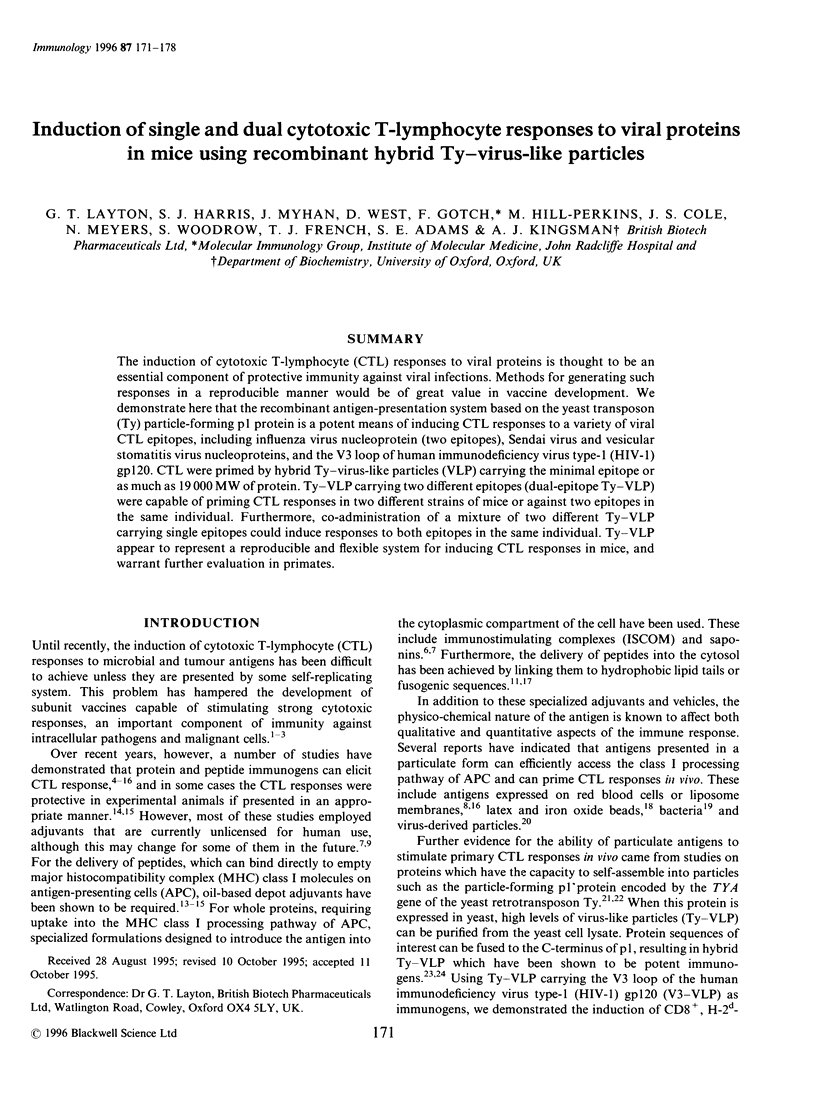

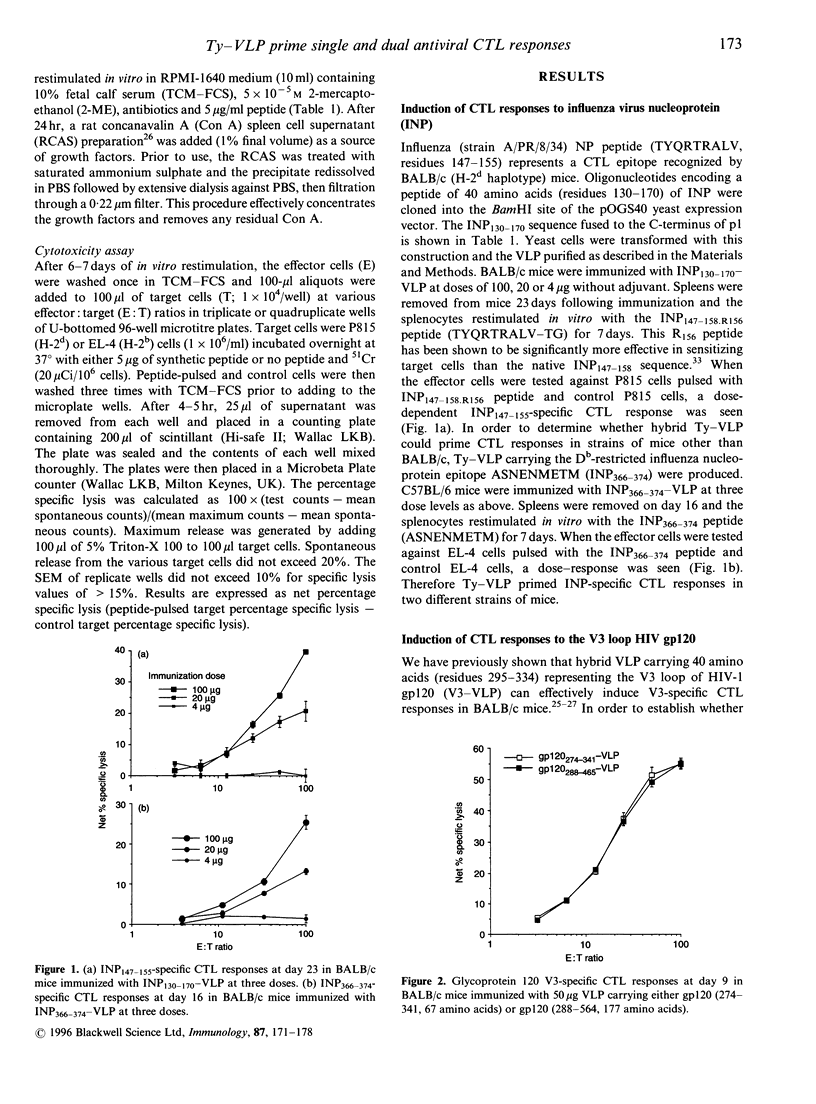
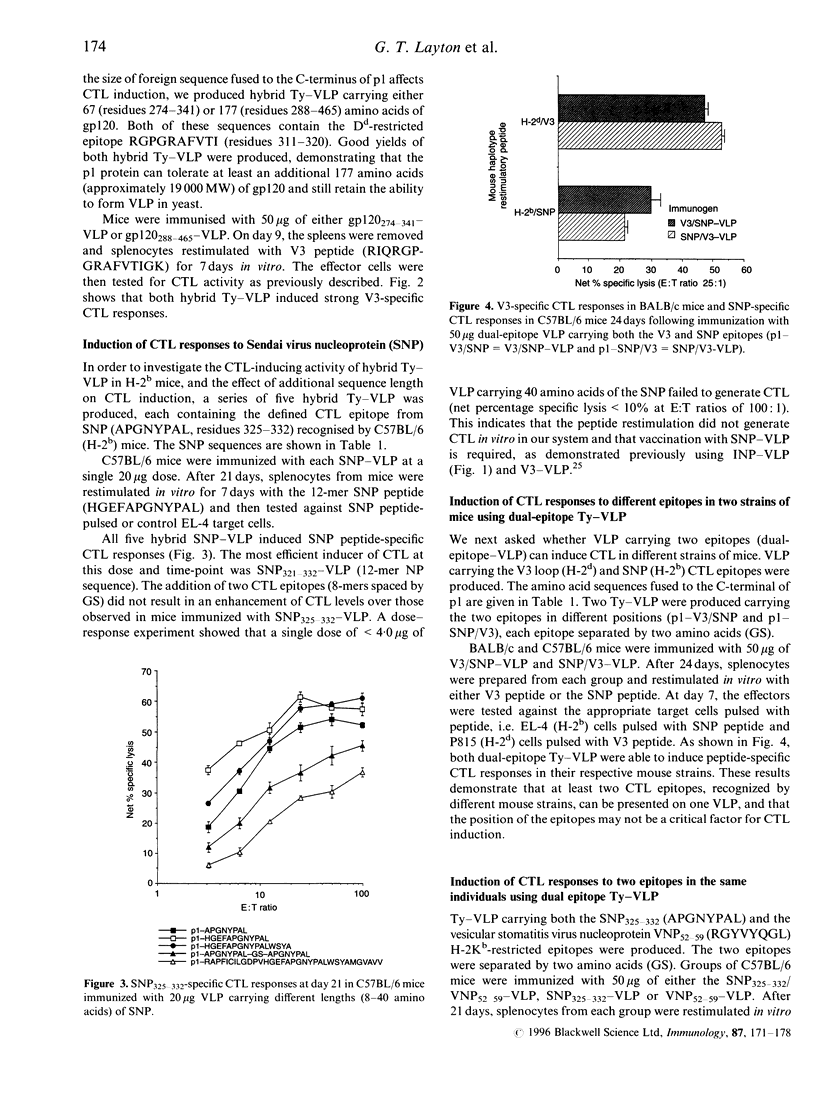
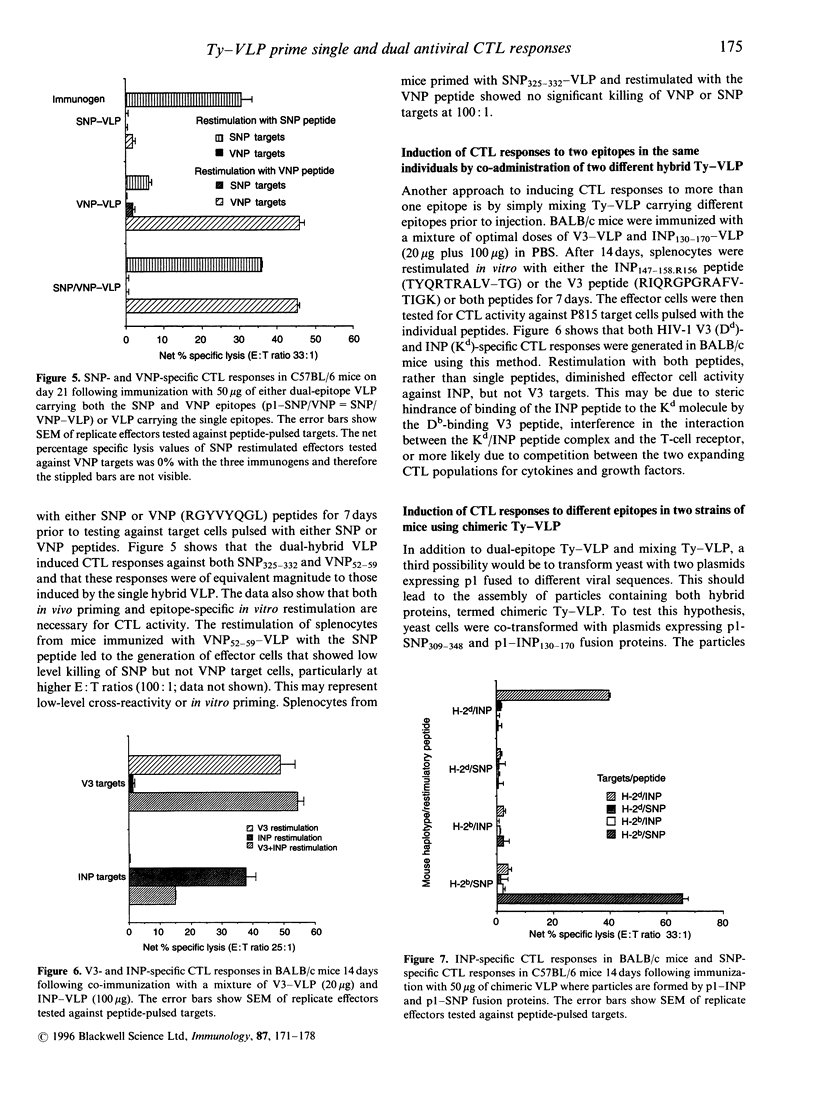
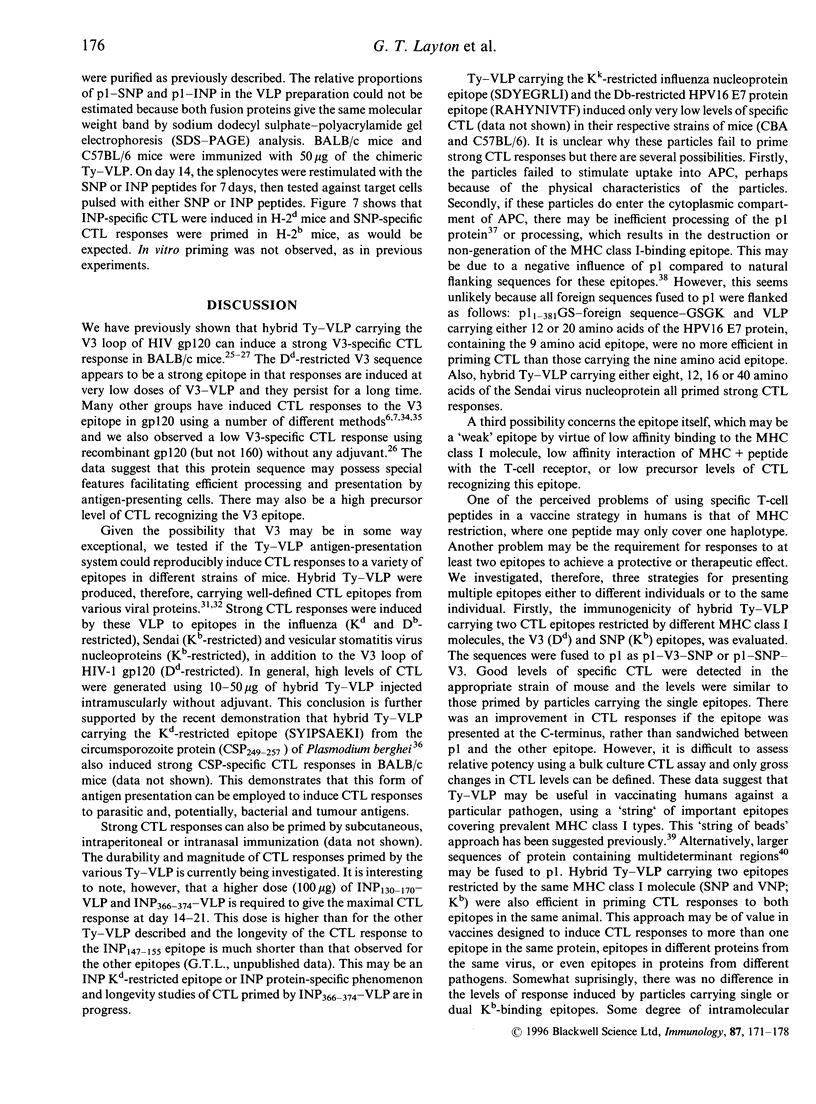
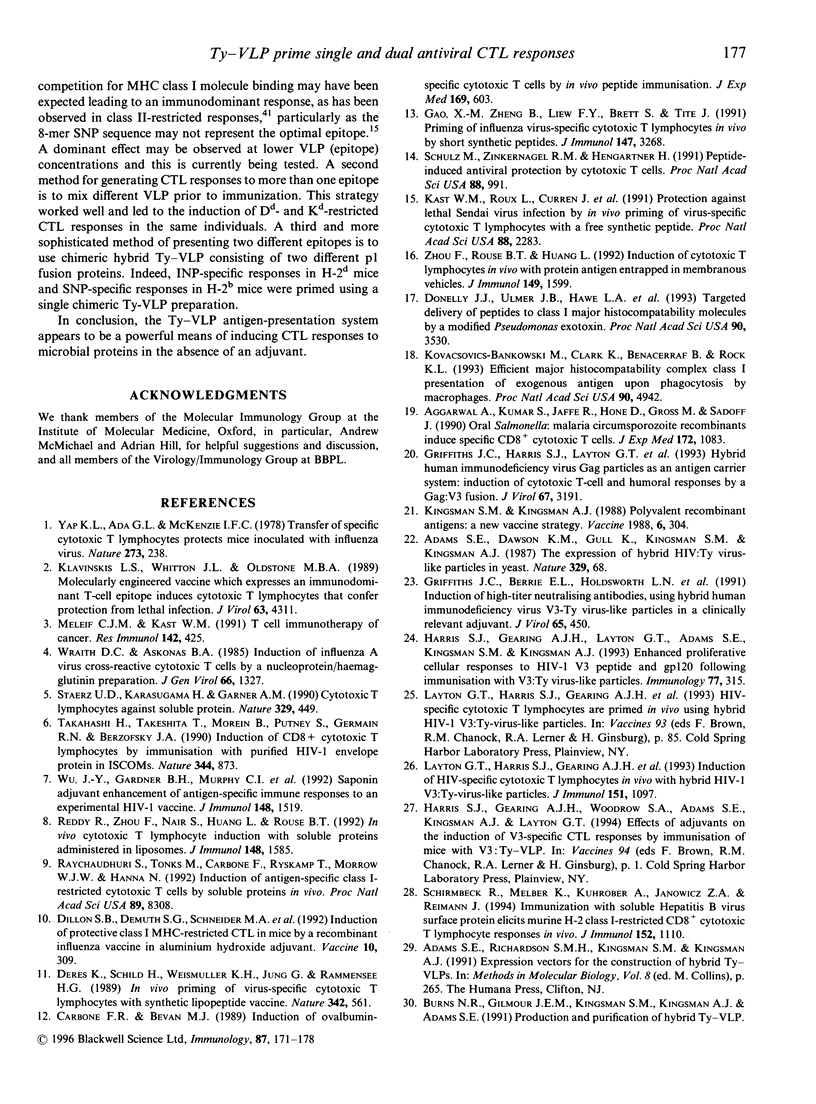
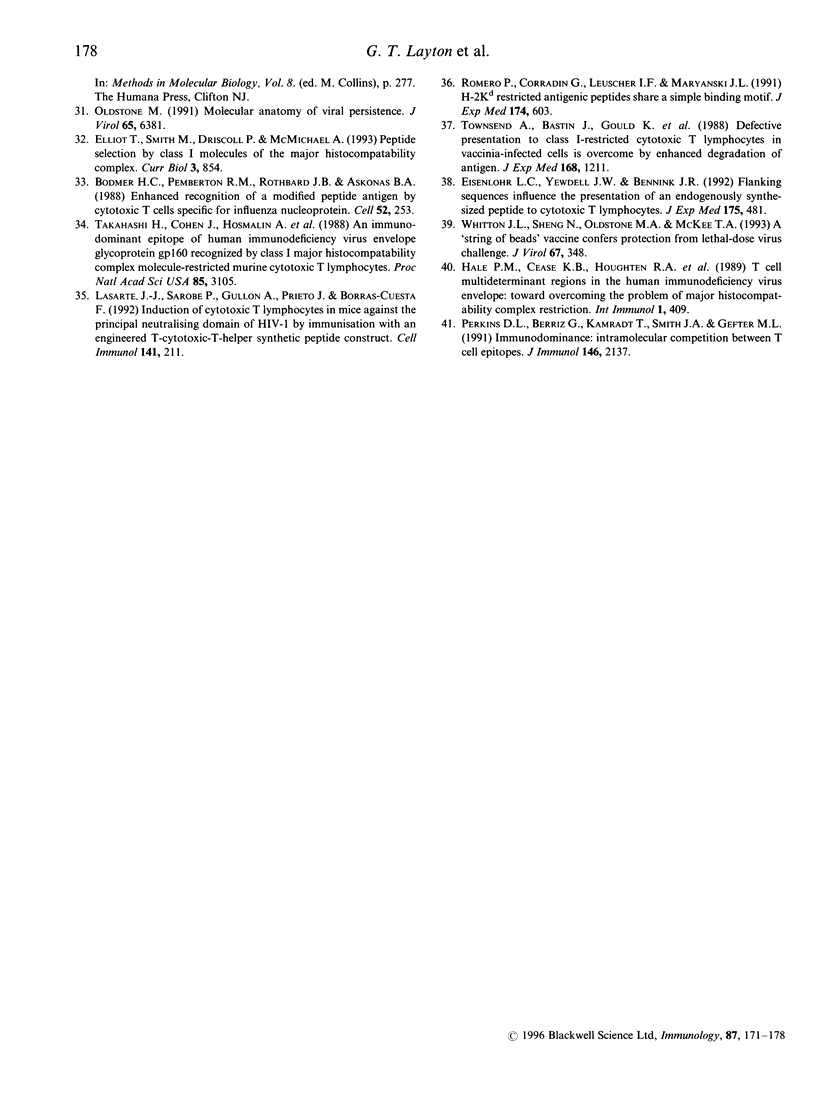
Selected References
These references are in PubMed. This may not be the complete list of references from this article.
- Adams S. E., Dawson K. M., Gull K., Kingsman S. M., Kingsman A. J. The expression of hybrid HIV:Ty virus-like particles in yeast. Nature. 1987 Sep 3;329(6134):68–70. doi: 10.1038/329068a0. [DOI] [PubMed] [Google Scholar]
- Aggarwal A., Kumar S., Jaffe R., Hone D., Gross M., Sadoff J. Oral Salmonella: malaria circumsporozoite recombinants induce specific CD8+ cytotoxic T cells. J Exp Med. 1990 Oct 1;172(4):1083–1090. doi: 10.1084/jem.172.4.1083. [DOI] [PMC free article] [PubMed] [Google Scholar]
- Bodmer H. C., Pemberton R. M., Rothbard J. B., Askonas B. A. Enhanced recognition of a modified peptide antigen by cytotoxic T cells specific for influenza nucleoprotein. Cell. 1988 Jan 29;52(2):253–258. doi: 10.1016/0092-8674(88)90514-4. [DOI] [PubMed] [Google Scholar]
- Carbone F. R., Bevan M. J. Induction of ovalbumin-specific cytotoxic T cells by in vivo peptide immunization. J Exp Med. 1989 Mar 1;169(3):603–612. doi: 10.1084/jem.169.3.603. [DOI] [PMC free article] [PubMed] [Google Scholar]
- Deres K., Schild H., Wiesmüller K. H., Jung G., Rammensee H. G. In vivo priming of virus-specific cytotoxic T lymphocytes with synthetic lipopeptide vaccine. Nature. 1989 Nov 30;342(6249):561–564. doi: 10.1038/342561a0. [DOI] [PubMed] [Google Scholar]
- Dillon S. B., Demuth S. G., Schneider M. A., Weston C. B., Jones C. S., Young J. F., Scott M., Bhatnaghar P. K., LoCastro S., Hanna N. Induction of protective class I MHC-restricted CTL in mice by a recombinant influenza vaccine in aluminium hydroxide adjuvant. Vaccine. 1992;10(5):309–318. doi: 10.1016/0264-410x(92)90369-u. [DOI] [PubMed] [Google Scholar]
- Donnelly J. J., Ulmer J. B., Hawe L. A., Friedman A., Shi X. P., Leander K. R., Shiver J. W., Oliff A. I., Martinez D., Montgomery D. Targeted delivery of peptide epitopes to class I major histocompatibility molecules by a modified Pseudomonas exotoxin. Proc Natl Acad Sci U S A. 1993 Apr 15;90(8):3530–3534. doi: 10.1073/pnas.90.8.3530. [DOI] [PMC free article] [PubMed] [Google Scholar]
- Eisenlohr L. C., Yewdell J. W., Bennink J. R. Flanking sequences influence the presentation of an endogenously synthesized peptide to cytotoxic T lymphocytes. J Exp Med. 1992 Feb 1;175(2):481–487. doi: 10.1084/jem.175.2.481. [DOI] [PMC free article] [PubMed] [Google Scholar]
- Elliott T., Smith M., Driscoll P., McMichael A. Peptide selection by class I molecules of the major histocompatibility complex. Curr Biol. 1993 Dec 1;3(12):854–866. doi: 10.1016/0960-9822(93)90219-e. [DOI] [PubMed] [Google Scholar]
- Gao X. M., Zheng B., Liew F. Y., Brett S., Tite J. Priming of influenza virus-specific cytotoxic T lymphocytes vivo by short synthetic peptides. J Immunol. 1991 Nov 15;147(10):3268–3273. [PubMed] [Google Scholar]
- Griffiths J. C., Berrie E. L., Holdsworth L. N., Moore J. P., Harris S. J., Senior J. M., Kingsman S. M., Kingsman A. J., Adams S. E. Induction of high-titer neutralizing antibodies, using hybrid human immunodeficiency virus V3-Ty viruslike particles in a clinically relevant adjuvant. J Virol. 1991 Jan;65(1):450–456. doi: 10.1128/jvi.65.1.450-456.1991. [DOI] [PMC free article] [PubMed] [Google Scholar]
- Griffiths J. C., Harris S. J., Layton G. T., Berrie E. L., French T. J., Burns N. R., Adams S. E., Kingsman A. J. Hybrid human immunodeficiency virus Gag particles as an antigen carrier system: induction of cytotoxic T-cell and humoral responses by a Gag:V3 fusion. J Virol. 1993 Jun;67(6):3191–3198. doi: 10.1128/jvi.67.6.3191-3198.1993. [DOI] [PMC free article] [PubMed] [Google Scholar]
- Hale P. M., Cease K. B., Houghten R. A., Ouyang C., Putney S., Javaherian K., Margalit H., Cornette J. L., Spouge J. L., DeLisi C. T cell multideterminant regions in the human immunodeficiency virus envelope: toward overcoming the problem of major histocompatibility complex restriction. Int Immunol. 1989;1(4):409–415. doi: 10.1093/intimm/1.4.409. [DOI] [PubMed] [Google Scholar]
- Harris S. J., Gearing A. J., Layton G. T., Adams S. E., Kingsman A. J. Enhanced proliferative cellular responses to HIV-1 V3 peptide and gp120 following immunization with V3:Ty virus-like particles. Immunology. 1992 Nov;77(3):315–321. [PMC free article] [PubMed] [Google Scholar]
- Kast W. M., Roux L., Curren J., Blom H. J., Voordouw A. C., Meloen R. H., Kolakofsky D., Melief C. J. Protection against lethal Sendai virus infection by in vivo priming of virus-specific cytotoxic T lymphocytes with a free synthetic peptide. Proc Natl Acad Sci U S A. 1991 Mar 15;88(6):2283–2287. doi: 10.1073/pnas.88.6.2283. [DOI] [PMC free article] [PubMed] [Google Scholar]
- Kingsman S. M., Kingsman A. J. Polyvalent recombinant antigens: a new vaccine strategy. Vaccine. 1988 Aug;6(4):304–306. doi: 10.1016/0264-410x(88)90174-0. [DOI] [PubMed] [Google Scholar]
- Klavinskis L. S., Whitton J. L., Oldstone M. B. Molecularly engineered vaccine which expresses an immunodominant T-cell epitope induces cytotoxic T lymphocytes that confer protection from lethal virus infection. J Virol. 1989 Oct;63(10):4311–4316. doi: 10.1128/jvi.63.10.4311-4316.1989. [DOI] [PMC free article] [PubMed] [Google Scholar]
- Kovacsovics-Bankowski M., Clark K., Benacerraf B., Rock K. L. Efficient major histocompatibility complex class I presentation of exogenous antigen upon phagocytosis by macrophages. Proc Natl Acad Sci U S A. 1993 Jun 1;90(11):4942–4946. doi: 10.1073/pnas.90.11.4942. [DOI] [PMC free article] [PubMed] [Google Scholar]
- Layton G. T., Harris S. J., Gearing A. J., Hill-Perkins M., Cole J. S., Griffiths J. C., Burns N. R., Kingsman A. J., Adams S. E. Induction of HIV-specific cytotoxic T lymphocytes in vivo with hybrid HIV-1 V3:Ty-virus-like particles. J Immunol. 1993 Jul 15;151(2):1097–1107. [PubMed] [Google Scholar]
- Melief C. J., Kast W. M. T-cell immunotherapy of cancer. Res Immunol. 1991 Jun-Aug;142(5-6):425–429. doi: 10.1016/0923-2494(91)90042-h. [DOI] [PubMed] [Google Scholar]
- Oldstone M. B. Molecular anatomy of viral persistence. J Virol. 1991 Dec;65(12):6381–6386. doi: 10.1128/jvi.65.12.6381-6386.1991. [DOI] [PMC free article] [PubMed] [Google Scholar]
- Perkins D. L., Berriz G., Kamradt T., Smith J. A., Gefter M. L. Immunodominance: intramolecular competition between T cell epitopes. J Immunol. 1991 Apr 1;146(7):2137–2144. [PubMed] [Google Scholar]
- Raychaudhuri S., Tonks M., Carbone F., Ryskamp T., Morrow W. J., Hanna N. Induction of antigen-specific class I-restricted cytotoxic T cells by soluble proteins in vivo. Proc Natl Acad Sci U S A. 1992 Sep 1;89(17):8308–8312. doi: 10.1073/pnas.89.17.8308. [DOI] [PMC free article] [PubMed] [Google Scholar]
- Reddy R., Zhou F., Nair S., Huang L., Rouse B. T. In vivo cytotoxic T lymphocyte induction with soluble proteins administered in liposomes. J Immunol. 1992 Mar 1;148(5):1585–1589. [PubMed] [Google Scholar]
- Romero P., Corradin G., Luescher I. F., Maryanski J. L. H-2Kd-restricted antigenic peptides share a simple binding motif. J Exp Med. 1991 Sep 1;174(3):603–612. doi: 10.1084/jem.174.3.603. [DOI] [PMC free article] [PubMed] [Google Scholar]
- Schirmbeck R., Melber K., Kuhröber A., Janowicz Z. A., Reimann J. Immunization with soluble hepatitis B virus surface protein elicits murine H-2 class I-restricted CD8+ cytotoxic T lymphocyte responses in vivo. J Immunol. 1994 Feb 1;152(3):1110–1119. [PubMed] [Google Scholar]
- Schulz M., Zinkernagel R. M., Hengartner H. Peptide-induced antiviral protection by cytotoxic T cells. Proc Natl Acad Sci U S A. 1991 Feb 1;88(3):991–993. doi: 10.1073/pnas.88.3.991. [DOI] [PMC free article] [PubMed] [Google Scholar]
- Staerz U. D., Karasuyama H., Garner A. M. Cytotoxic T lymphocytes against a soluble protein. Nature. 1987 Oct 1;329(6138):449–451. doi: 10.1038/329449a0. [DOI] [PubMed] [Google Scholar]
- Takahashi H., Cohen J., Hosmalin A., Cease K. B., Houghten R., Cornette J. L., DeLisi C., Moss B., Germain R. N., Berzofsky J. A. An immunodominant epitope of the human immunodeficiency virus envelope glycoprotein gp160 recognized by class I major histocompatibility complex molecule-restricted murine cytotoxic T lymphocytes. Proc Natl Acad Sci U S A. 1988 May;85(9):3105–3109. doi: 10.1073/pnas.85.9.3105. [DOI] [PMC free article] [PubMed] [Google Scholar]
- Takahashi H., Takeshita T., Morein B., Putney S., Germain R. N., Berzofsky J. A. Induction of CD8+ cytotoxic T cells by immunization with purified HIV-1 envelope protein in ISCOMs. Nature. 1990 Apr 26;344(6269):873–875. doi: 10.1038/344873a0. [DOI] [PubMed] [Google Scholar]
- Townsend A., Bastin J., Gould K., Brownlee G., Andrew M., Coupar B., Boyle D., Chan S., Smith G. Defective presentation to class I-restricted cytotoxic T lymphocytes in vaccinia-infected cells is overcome by enhanced degradation of antigen. J Exp Med. 1988 Oct 1;168(4):1211–1224. doi: 10.1084/jem.168.4.1211. [DOI] [PMC free article] [PubMed] [Google Scholar]
- Whitton J. L., Sheng N., Oldstone M. B., McKee T. A. A "string-of-beads" vaccine, comprising linked minigenes, confers protection from lethal-dose virus challenge. J Virol. 1993 Jan;67(1):348–352. doi: 10.1128/jvi.67.1.348-352.1993. [DOI] [PMC free article] [PubMed] [Google Scholar]
- Wraith D. C., Askonas B. A. Induction of influenza A virus cross-reactive cytotoxic T cells by a nucleoprotein/haemagglutinin preparation. J Gen Virol. 1985 Jun;66(Pt 6):1327–1331. doi: 10.1099/0022-1317-66-6-1327. [DOI] [PubMed] [Google Scholar]
- Wu J. Y., Gardner B. H., Murphy C. I., Seals J. R., Kensil C. R., Recchia J., Beltz G. A., Newman G. W., Newman M. J. Saponin adjuvant enhancement of antigen-specific immune responses to an experimental HIV-1 vaccine. J Immunol. 1992 Mar 1;148(5):1519–1525. [PubMed] [Google Scholar]
- Yap K. L., Ada G. L., McKenzie I. F. Transfer of specific cytotoxic T lymphocytes protects mice inoculated with influenza virus. Nature. 1978 May 18;273(5659):238–239. doi: 10.1038/273238a0. [DOI] [PubMed] [Google Scholar]
- Zhou F., Rouse B. T., Huang L. Induction of cytotoxic T lymphocytes in vivo with protein antigen entrapped in membranous vehicles. J Immunol. 1992 Sep 1;149(5):1599–1604. [PubMed] [Google Scholar]


